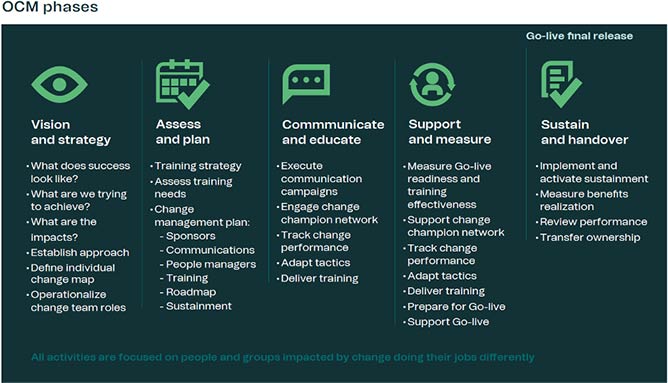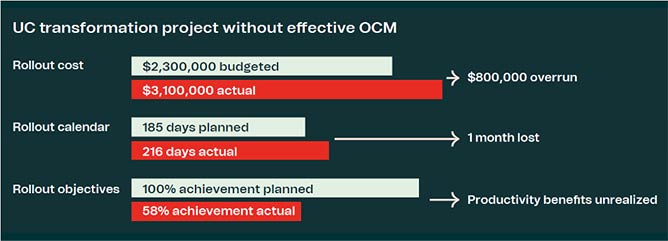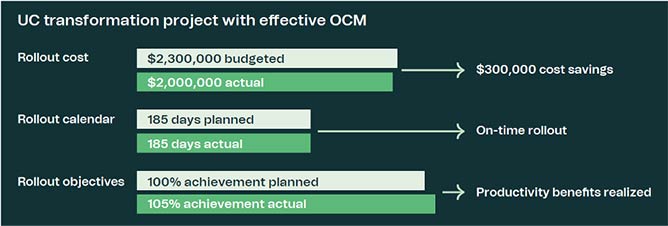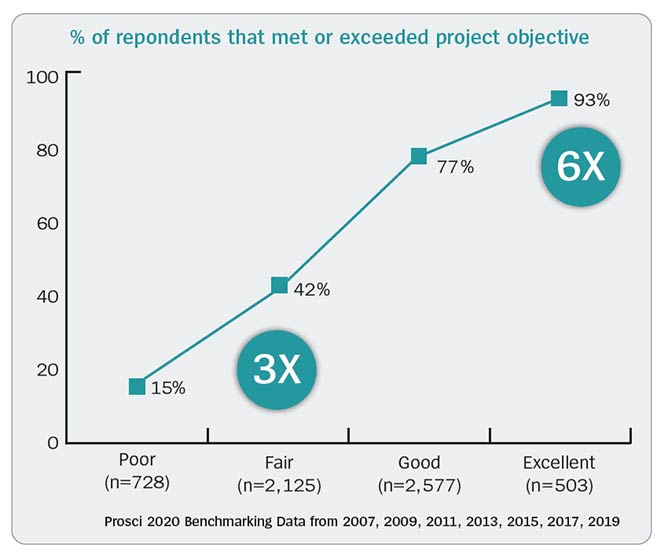Organizational change management: The critical link to digital transformation in the hybrid workplace
November 1, 2021 / Unisys Corporation
Short on time? Read the key takeaways:
- The hybrid office has become the norm in the post-pandemic world, leading to a digital revolution in businesses.
- A solid OCM methodology that applies a structured process and set of tools is needed to address the human factor in organizational change so business objectives can be attained at both a project and an organizational level.
- OCM can help organizations better align with compliance regulations while creating a secure learning environment
- Only with effective change management will end users adopt and leverage whatever new technology solutions are implemented.
With today’s dynamic environment pushing employees and companies to adapt quickly to stay competitive, many organizations are in the throes of massive upheaval.
Technology solutions to support increasingly hybrid workplaces and digital enterprises are similarly evolving rapidly in the hopes of maximizing success and business outcomes. But the right technology does not automatically guarantee employee productivity. Instead, companies reliably see productivity solutions adopted and sustained only when technology is coupled with effective organizational change management (OCM).
Prosci, a global leader in change management, reports that businesses with excellent OCM are an astonishing six times more likely to meet or exceed their project objectives than those with poor OCM practices. They are also more likely to stay on or ahead of schedule and more likely to stay on or under budget.
Digital agendas vs. the human factor
The tremendous return on investment (ROI) of OCM is the result of addressing the human factor within digital transformation. While companies have digital agendas and want to digitize their workforces, their employees’ digital dexterity and motivation to change vary widely. Some employees are eager adopters, whereas others resist new technologies. Some employees can readily figure out how to use new technologies, while another segment cannot do so independently. One group of employees might be motivated by the clear benefits of the latest solutions. In contrast, another group may not see any value in the transition.
There are other considerations. For instance, the needs and responsibilities of division managers faced with digital change differ from those of the people they lead. When enterprises roll out new technology and fail to consider the human factor, they do not see the expected cost reductions or productivity improvements they anticipated and counted on.
A robust OCM process with all the embedded resources and ancillary activities is critical to motivating end users and helping them become digitally dexterous. This is true whether speaking of hourly workers, supervisors, middle management or the C-suite. Helping end users successfully navigate change is what OCM is all about.
OCM and digital transformation
A solid OCM methodology applies a structured process and set of tools to address the human factor in organizational change so that business objectives can be attained at both a project and an organizational level. At the project level, OCM ensures that employees are engaged to adopt and proficiently use new tools and approaches in their work environment. At an organizational level, change management is defined as a leadership competency for enabling organizational change and a strategic capability designed to increase change capacity and responsiveness.
Unisys Organizational Change Management uses a five-phase approach to OCM shown here:

This full-featured lifecycle methodology:
- Avoids unnecessary costs by promoting high adoption and engagement
- Reduces the impact of change by effectively preparing the workforce
- Increases the speed of adoption, utilization, and proficiency through tailored training
- Provides a roadmap to drive the change journey at all levels of the organization
- Resolves resistance to change through targeted communication
- Ensures sustainability via continuing change management tactics after go-live
- Aligns people and processes to meet business objectives
This proven OCM methodology has borne out Prosci’s research in real-world scenarios. For example, Unisys clients have seen digital transformation ROI increase with effective sponsorship, aligning with findings that “73% of respondents with extremely effective sponsors met or exceeded objectives compared to 29% with extremely ineffective sponsors.”
It must be noted that ongoing change management after go-live has also been demonstrated to be of critical importance.
A tale of two digital initiatives
To better grasp the implication of these statistics, consider two companies with initiatives to bring UCC to their now-hybrid workforces: ABC Inc. and XYZ Corp. The companies are the same in several key aspects: they are in the same industry, have the same number of employees and have the same budget, timeline and objectives for digital transformation. Where they differ is in their treatment of OCM.
ABC Inc. — no effective OCM
ABC Inc. invests in a great set of UCC solutions. They have an executive sponsor, but she is so crunched for time that she cannot do much “championing” of the new toolset. They send out communications several times via email announcing the upcoming changes. Still, a significant portion of their employees do not understand the importance or benefits of what is said – and some miss the emails entirely. Basic training is offered but is not made mandatory; there is an underlying assumption that employees will “get it” without significant guidance.
Go-live comes and goes... and not much changes for most employees. Documents are still emailed back and forth, continuing the pre-existing versioning nightmare. Virtual meetings still have participants writing on physical whiteboards and notepads, while smart whiteboards are ignored. Files are still being saved to personal hard drives, making them inaccessible for dynamic collaboration. The list goes on and on.
The leadership in ABC Inc. is terribly frustrated. They scramble to do retroactive communications and training, which costs time and money. However, they did not analyze what happened or why even these after-the-fact efforts fell short. The ultimate productivity payout is much less than it had been banked on.

XYZ Corp. — effective OCM
XYZ Corp. also invests in a great set of UCC solutions. But right at the start, they prioritize OCM. They begin with interviews and surveys to determine the level of understanding about UCC, who needs training and who needs convincing. Their initial assessment shows a large knowledge gap and a poor understanding of the value of UCC. The OCM team launches an aggressive awareness campaign with videos, Yammer posts, gamification and more to communicate knowledge and motivate the workforce. A second survey a month later shows the company in a significantly improved state of readiness for digital transformation.
Active executive sponsorship, consistent communication and role-targeted training occur regularly up to the rollout date, which occurs on time and under budget. The go-live is smooth, and employees are excited to put the new solutions into practice. There is an immediate uptick in remote collaboration, document sharing, hybrid office meetings, etc.
But the OCM team members do not consider their work done. They watch usage metrics carefully and notice that one collaboration functionality is underused from what had been expected. They conduct targeted trainings for that function and see usage jump over the next several weeks.
About two months after rollout, the OCM team notes that one department is significantly behind the others in adoption. They perform interviews and surveys to determine where resistance exists and take steps to overcome the department’s inertia. Several weeks of steady communication and the involvement of project champions successfully engaged the department’s personnel with the new UCC solutions. At the next leadership meeting, the OCM team can report that the digital transformation has more than achieved the desired goals and objectives across the enterprise.

Exceeding expectations amid continual change
Whether a technology initiative centers around the digital workplace, cloud and infrastructure, enterprise computing, business processes or cybersecurity, that initiative will involve change. Therefore, for businesses to achieve digital transformation and realize a return on their investment, OCM is of paramount importance. Only with effective change management will end users adopt and leverage whatever new technology solutions are implemented.
Businesses that take a proactive and deliberate approach to communications, support, training, execution, measurement and sustainment will see the results that Prosci has documented in its research. Namely, they will be twice as likely to stay on or under budget, more likely to stay on or ahead of schedule and more likely to meet or exceed their project objectives.
Companies that prioritize OCM will also be well-prepared for the next digital initiative. Because the fact is, digital transformation is never done. It is just a matter of time before a new solution needs to be launched and adopted. With robust OCM in place, that eventuality can be welcomed with open arms.




















